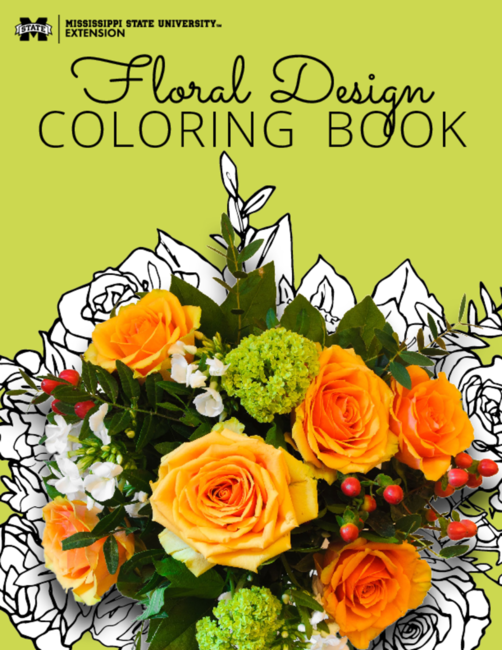P3240
Floral Design Coloring Book
Download the PDF here or contact your county Extension office to request a copy of the Floral Design Coloring Book (P3240)!
Coloring Tips
For best results, use colored pencils, crayons, or gel pens. Markers are fine, but their inks may bleed through the page. If you use markers, you will need something underneath the page you are coloring to keep the marker from bleeding or soaking through to the next coloring sheet. A scrap sheet of paper or a piece of cardboard are good options.
Versatile Flowers
Flowers are not only beautiful but also interesting! Many times, when you think of flowers, you think about the colors and smells they provide, but they also provide opportunities to learn science and be creative through artistic expression. Flowers give color to the world and can brighten your day.
Flower People & Colors
Flowers are available in many different colors!
Floriculture breeders (scientists who change the traits of plants) create new flowers with different color combinations all the time. A plant explorer may find a red flowering plant in the wild, and then plant breeders can use their knowledge and skills to grow that same kind of plant in pink, purple, or maybe even yellow.
Floral designers are artists who combine different things together to create arrangements. Flowers, containers, ribbons, table cloths, and backgrounds all come together to make a setting special.
You can create beautiful floral designs just like the pros by learning a few techniques.
Color Wheel
Different colors are grouped from the color wheel in schemes. These color schemes help the artist plan for how to use the colors.
The primary colors are red, yellow, and blue. A red rose, a blue iris, and a yellow daffodil can be grouped together to make a primary-color arrangement.
A second group of colors is made by mixing two primary colors together. The secondary colors are violet, orange, and green. Purple carnations, orange lilies, and green gladiolus would make a stunning secondary-color arrangement.
A third group of colors is formed by mixing one primary color and one secondary color. These are red-violet, red-orange, blue-violet, blue-green, yellow-orange, and yellow-green. Eucalyptus leaves are blue-green, zinnias are red-violet, and marigolds are yellow-orange!
Tints, Tones, & Shades
Tint means to add white to a color. A tint of red gives you pink.
Tone means to add gray to a color. A tone of green makes sage green.
Shade means to add black to a color. A shade of blue creates midnight blue.
Monochromatic Color Scheme
A monochromatic color scheme includes one color and any of its tints, tones, and shades.
For example, a monochromatic color scheme of yellow food would be butter, cheese, bananas, peppers, and mustard! Or maybe you prefer green apples, mint, limes, and string beans?
Analogous Color Scheme
An analogous color scheme uses two, three, or four side-by-side colors on the color wheel.
For example, blue-violet, blue, and violet would be pretty to color a nighttime sky. A bowl of fresh blueberries (blue-violet), raspberries (red-violet), and grapes (deep purple) are a healthy and beautiful snack.
Complementary Color Scheme
A complementary color scheme uses opposites on the color wheel.
Red and green, violet and yellow, blue and orange, red-violet and yellow-green, blue-violet and yellow-orange, blue-green and red-orange—all of these are complementary colors!
Make Your Own Arrangement
Materials
- Jar
- Flowers
- Scissors
- Ribbon
- Access to water
Steps
- Select a clean, empty jar; any kind will do!
- Fill it about halfway with water.
- Choose flowers from your yard or buy them from a store.
- Make sure the flowers fit the container you selected. It is best to keep flower height about 1.5 to 2 times the height of the jar.
- Cut the stems at an angle with scissors and place in the jar.
- Tie a bow around the jar’s neck to make it extra special.
Make a Flower Crown
This is a fun project to make with others. An adult can help you to find the right supplies and make the design.
Materials
- Wire cutters
- Scissors
- Wire (such as 12-gauge aluminum craft wire) to create base
- Light wire (such as bullion, 28-gauge wire, or string)
- Flowers, greenery
Steps
- Crowns can be a half circle or even a full circle. Any type is fine, small to large!
- To make a traditional crown, measure the 12-gauge wire to fit the crown of your head. With an adult’s help, carefully bring a piece of wire around the crown of your head. Take care to keep the sharp ends of the wire away from your eyes.
- Fold the ends of the wire back so that they won’t scratch you.
- Cut flowers and leaves into small bunches, about 2 inches long.
- Now, lay the 12-gauge aluminum wire straight and flat.
- On one end, wind the light wire around the heavier base wire several times to keep it in place.
- Next, wrap a small bunch of the flowers onto the base wire. Overlap it a few times to secure the flowers.
- Repeat this process until you reach the opposite side of the base wire.
- Wrap the light wire around the end several times to fasten it.
- Bend the design into a curve.
- A few bobby pins will keep it in place.
Publication 3240 (09-25)
By James M. DelPrince, PhD, AIFD, PFCI, Associate Extension Professor/Horticulture Specialist, Coastal Research and Extension Center; and Lori Elmore-Staton, PhD, Professor, Human Sciences.
The Mississippi State University Extension Service is working to ensure all web content is accessible to all users. If you need assistance accessing any of our content, please email the webteam or call 662-325-2262.
